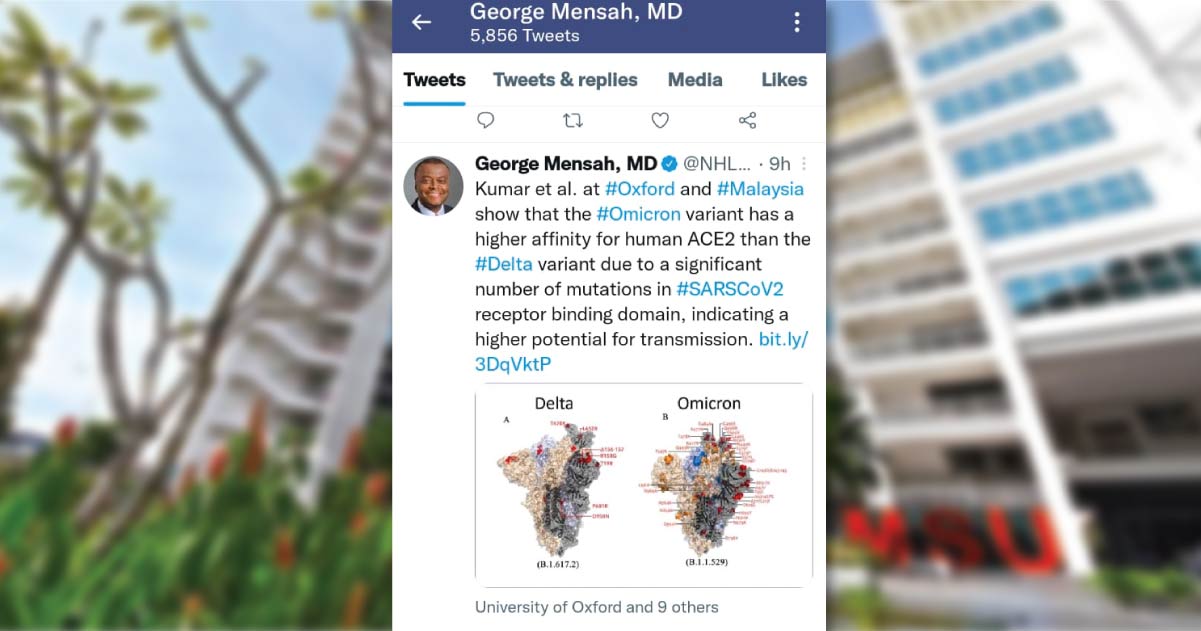

Scientists worldwide are scrambling to characterize the Omicron variant; particularly to learn how contagious, how vaccine resistant, and how severe the diseases it can cause could be.
B.1.1.529, the coronavirus variant that would later be designated as Omicron, presents over 30 mutations on its spike protein – the outer covering targeted by vaccines and the natural immune response.
Such high mutations had not been observed in other strains. It distinguishes Omicron from those of the virus that first emerged in late 2019 – a time since when, more than 20 variants have been identified and tracked by the World Health Organization.
Omicron’s spike proteins could render it less vulnerable to neutralization by either vaccine-generated antibodies or natural immunity from past COVID-19 infections. Unlike in the Lambda and the Mu variants, early signs point to the need for swift attention on the Omicron’s mutations.
Even before it was named, Omicron had gained such attention from COVID researchers; among them, Oxford researchers led by Dr Suresh Kumar of Management and Science University (MSU) and MSU student of Bachelor in Bioinformatics (Hons) Thiviya S. Thambiraja; both at MSU Malaysia's Faculty of Health and Life Sciences (FHLS).


Their research, just accepted by the Journal of Medical Virology, 'provides valuable insight into the Omicron and the Delta variants and the mutations that drive them'. It has appeared as a spotlight paper on the Centers for Disease Control and Prevention (CDC) website, highlighted on the Australian Government’s COVID-19 Critical Intelligence Unit brief report, cited in the Ontario Public Health Evidence Brief risk assessment report, and presented on various online news portal.
The work, a comparative computational study of spike protein between Omicron and Delta variants of SARS-CoV-2, found that the Omicron variant had a higher affinity for human ACE2 – angiotensin-converting enzyme 2, which is the protein that provides the entry point for the coronavirus to hook into and infect human cells.
The first to report Omicron’s potential for higher transmissibility as compared with Delta’s, this research provides a large amount of information that could help further investigations into how quickly Omicron could spread and how damaging it can be.
RELATED
Living her dream in Oxford through MSU
Finding her calling in research
Cancer and cell biology: A case for Biomedical Sciences
Making waves in Biomedical Science
MSU Bachelor of Medical Sciences (Hons)
MSU Bachelor of Biomedical Science (Hons)
MSU Master in Biomedical Sciences
MSU Master in Science (by Research) Biomedicine
MSU Doctor of Philosophy (by Research) in Biomedicine
Scientists worldwide are scrambling to characterize the Omicron variant; particularly to learn how contagious, how vaccine resistant, and how severe the diseases it can cause could be.
B.1.1.529, the coronavirus variant that would later be designated as Omicron, presents over 30 mutations on its spike protein – the outer covering targeted by vaccines and the natural immune response.
Such high mutations had not been observed in other strains. It distinguishes Omicron from those of the virus that first emerged in late 2019 – a time since when, more than 20 variants have been identified and tracked by the World Health Organization.
Omicron’s spike proteins could render it less vulnerable to neutralization by either vaccine-generated antibodies or natural immunity from past COVID-19 infections. Unlike in the Lambda and the Mu variants, early signs point to the need for swift attention on the Omicron’s mutations.
Even before it was named, Omicron had gained such attention from COVID researchers; among them, Oxford researchers led by Dr Suresh Kumar of Management and Science University (MSU) and MSU student of Bachelor in Bioinformatics (Hons) Thiviya S. Thambiraja; both at MSU Malaysia's Faculty of Health and Life Sciences (FHLS).


Their research, just accepted by the Journal of Medical Virology, 'provides valuable insight into the Omicron and the Delta variants and the mutations that drive them'. It has appeared as a spotlight paper on the Centers for Disease Control and Prevention (CDC) website, highlighted on the Australian Government’s COVID-19 Critical Intelligence Unit brief report, cited in the Ontario Public Health Evidence Brief risk assessment report, and presented on various online news portal.
The work, a comparative computational study of spike protein between Omicron and Delta variants of SARS-CoV-2, found that the Omicron variant had a higher affinity for human ACE2 – angiotensin-converting enzyme 2, which is the protein that provides the entry point for the coronavirus to hook into and infect human cells.
The first to report Omicron’s potential for higher transmissibility as compared with Delta’s, this research provides a large amount of information that could help further investigations into how quickly Omicron could spread and how damaging it can be.
RELATED
Living her dream in Oxford through MSU
Finding her calling in research
Cancer and cell biology: A case for Biomedical Sciences
Making waves in Biomedical Science
MSU Bachelor of Medical Sciences (Hons)
MSU Bachelor of Biomedical Science (Hons)
MSU Master in Biomedical Sciences
MSU Master in Science (by Research) Biomedicine
MSU Doctor of Philosophy (by Research) in Biomedicine